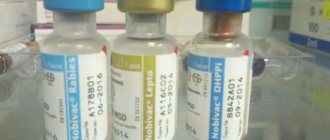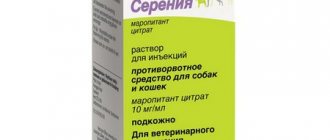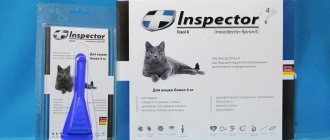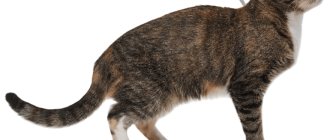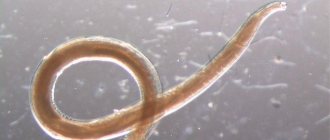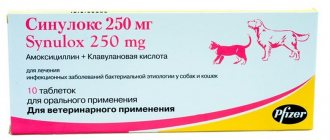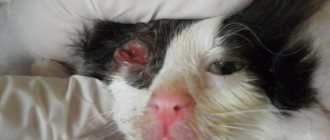COMPOUND
Active substance:
- Feliferon for cats, according to the instructions, 1 ml contains feline interferon with antiviral activity of 400,000 IU as an active ingredient
Excipients:
- dextran-40 50.00 mg
- sodium salt of ethylenediaminetetraacetic acid 0.07 mg
- sodium acetate 1.64 mg
- sodium chloride 5.84 mg
- polysorbate-20 0.10 mg
- glacial acetic acid about 0.0045 ml
- water for injection up to 1 ml
PHARMACOLOGICAL PROPERTIES OF FELIFERON
Pharmacological group: immunomodulators, drugs with antiviral activity. Feliferon for cats has an immunostimulating and antiviral effect.
The mechanism of action consists of:
- increased phagocytic activity of macrophages in cats
- increasing the specific cytotoxicity of lymphocytes
- increasing the resistance of healthy cells of the cat’s body to infection with viruses
- in suppressing the reproduction of RNA and DNA viruses in infected cells
According to the degree of impact on the cat’s body, Feliferon is classified as a low-hazard substance
(grade 4), in recommended doses does not have a skin irritant or resorptive toxic effect.
Analogues of the product
It is not always possible to find a specific medicine, or it may not be suitable due to the dosage form. There are different analogues of Feliferon for cats. Neoferon is available in tablet form; it contains a complex of 13 plants that stimulate the immune system and cause its increase. Inulin is a prebiotic and allows you to restore intestinal microflora, which improves the body's resistance.
Nephoren is prescribed as a supportive agent for various diseases, accelerating recovery after operations. It has an antiseptic, immunomodulatory effect. In case of damage to soft tissues, the drug prevents the appearance of purulent wounds.
Tablets are easier to give to a cat. The product is mixed with food or injected into the mouth using a special device. The average course of treatment is 10 days. The drug has no side effects; in rare cases, individual intolerance to the components occurs.
Another effective immunomodulator is Immunofan . For cats, only the injectable form is used. It has a wide spectrum of action, it is effective for restoring and increasing the level of immunity, recovery after operations and injuries, and eliminates inflammatory processes. The advantage of Immunofan is the improvement of liver function.
Fosprenil is also an immunomodulator and is available in the form of an injection solution. Effective against a number of viral diseases - calcivirus, rhinotracheitis, herpesvirus and others. It is used to relieve gastrointestinal pathologies and peritonitis. Suppresses the development of pathogenic flora and promotes recovery.
Fosprenil can be taken by drinking water rather than given as injections. The average dose is calculated based on 0.5 ml per 1 kg of animal. Minor side effects may occur (drowsiness, apathy, lethargy, and so on).
Why use Feliferon to treat cats?
According to the instructions, feliferon is designed for the treatment of viral diseases of cats. Field studies of cats with calicivirus infection have shown a reduction in the severity and duration of clinical signs associated with the virus. The drug has also been used in the adjunctive therapy of cats with infectious peritonitis with uncertain clinical results.
Feliferon for cats has been used experimentally in the treatment of feline viral infections, including leukemia, immunodeficiency and coronavirus infection.
Feline interferon given prophylactically or therapeutically to cats experimentally infected with FIP does not reduce mortality. However, the high-dose protocol resulted in transient suppression of clinical signs and decreased serum antibody titers to FIP with increased survival time (weeks) compared to untreated cats. There are no good studies on the effect of this treatment on spontaneously occurring FIP infection, although one protocol has been described using human interferon alpha 30 IU/day orally for 7 days on alternating weeks for 6–7 weeks.
Feliferon in cats is indicated for the treatment of herpes keratitis.
Trials are currently underway to examine the potential benefits of interferon therapy for feline chronic gingivostomatitis.
Contraindications and side effects
It is important to check with your doctor for how many days to inject Feliferon, taking into account the cat’s condition, in order to speed up the animal’s recovery as much as possible. As for side effects, when using the solution in accordance with the instructions, they are not observed.
If individual intolerance is detected, it is necessary to stop giving injections to the cat, and also consult a doctor to prescribe antihistamines. Taking Feliferon is not recommended:
- after suffering from severe autoimmune and allergic diseases;
- within 10 days after vaccination;
- in case of disturbances in the functioning of the circulatory system;
- in case of malfunction of the nervous system.
Did you know? Australia is the world leader in the number of cat lovers: there are 9 cats per 10 inhabitants in this country.
INDICATIONS
Feliferon is prescribed to cats according to the instructions for use for therapeutic and prophylactic purposes for:
- feline herpesvirus (rhinotracheitis)
- panleukopenia
- calicivirus
- anemia and hypovitaminosis
- in the postoperative period
- in the postpartum period
- secondary immunodeficiency
- gastrointestinal
- invasive diseases
- acute respiratory
- poisoning
- other diseases of viral or mixed etiology
When is it appointed?
The drug turned out to be very effective against coronavirus infection in animals.
In veterinary practice, based on studies of the effectiveness of the drug, a group of scientists from the Scientific and Technological Institute uses Feliferon for coronavirus, calcivirosis and other dangerous viral diseases. For kittens and adults, Feliferon is also prescribed for the treatment of bacterial diseases of the digestive system, vitamin deficiency, anemia, acute respiratory infections, helminthic infestation, as well as after surgery in order to improve the immune system and reduce the risk of complications. In addition, the indication for the use of Feliferon is secondary immunodeficiency and the need to protect the body from viral diseases, for example, during an epidemic.
MODE OF APPLICATION
Feliferon solution for injection is administered intramuscularly to cats. If there is a threat of infection, the drug is prescribed at a dose of 200,000 IU per animal, twice with an interval of 48 hours. For the treatment of cats with viral, bacterial and mixed diseases, Feliferon is administered in a daily dose of 200,000 IU, for 5-7 days in combination with antibiotics, serum and immunoglobulin preparations, in accordance with the instructions for their use.
In severe cases of the disease and mixed infections, it is recommended to increase the average therapeutic dose by 2 times - 400,000 IU.
No overdose symptoms have been identified when using the drug. Avoid missing the next dose of Feliferon in cats, as this may lead to a decrease in therapeutic effectiveness. If one dose is missed, it is necessary to administer it to the cat as soon as possible, then the interval between administrations of the drug does not change.
Advantages
Veterinarians use Feliferon in their practice for the following reasons:
- Double action. The medication affects the viruses themselves and stimulates the immune system.
- Quick effect. The therapeutic effect appears after the first injection. Symptoms of the disease weaken and gradually disappear. Cats recover faster with a course of use of the solution. The positive dynamics are more persistent and pronounced, especially when compared with traditional treatment of infectious diseases.
- Does not provoke toxic effects. Even with prolonged use, it does not irritate the skin and does not cause intoxication of the kidneys and liver. During the studies, a lethal (deadly) toxic dose of Feliferon was not detected.
- Neutralizing antibodies are not produced. The solution can be used repeatedly without loss of therapeutic effect, since its use does not induce the production of antibodies to feline interferon.
Interesting! Multiple clinical trials of Feliferon were conducted on sick cats. According to their results, the drug (as part of complex therapy) is effective against rhinotracheitis, calcivirosis, mycoplasmosis, panleukopenia and chlamydia. It helps improve the dynamics of the above infections and shortens the recovery period.
Prevention measures:
If allergic reactions occur or if the drug accidentally enters the human body, you should immediately contact a medical facility (bring the instructions or label with you).
People with hypersensitivity to the components of the drug should avoid direct contact with the drug. When working with Feliferon for cats, you should follow the general rules of personal hygiene and safety precautions provided for when working with medications.
If a person accidentally comes into contact with the medicinal product with the skin or mucous membranes of the eyes, they must be rinsed with plenty of running water.
Empty drug bottles must not be used for household purposes; they must be disposed of with household waste.
Consumer Reviews
I have always been skeptical of domestic manufacturers. Cheap could not be high quality. Therefore, I was surprised when the veterinarian prescribed a course of Feliferon to restore the cat after giving birth. After the injections, she became interested in kittens, leaving the house and eating.
Anastasia
While relaxing at the dacha, the cat contracted an infectious disease. He was constantly vomiting and had diarrhea. I had to urgently return to the city and go to the vet. The doctor made a disappointing diagnosis and prescribed treatment. I believe that it was Feliferon that helped the animal recover.
Andrey
The cat suddenly caught a cold.
She didn't react to anything. The veterinarian prescribed treatment. Among the drugs was Feliferon. I was skeptical about the prescription, but completed the course. On the second day, the pet came to life and began to behave actively. He asked me to eat, drank water and responded to me. Elena
Learn about essential antimicrobials in animals
- Trichopolum instructions for veterinary medicine
- Instructions for the use of the antibiotic Baytril in animals
- Instructions for use of metronide
- Instructions for ceftriaxone preparations for animals
- Use of Metrogyl in veterinary medicine
- Instructions for doxycycline in animals
- Metronidazole (Metronidazole) for animals (instructions for use in veterinary medicine, doses, indications and contraindications)
- Atovaquone (ATOVAQUONE)
- Azithromycin, instructions for animal therapy
^Top
Adverse reactions
When Feliferon is used correctly, treatment proceeds well and no negative effects occur. Otherwise, cats may encounter a number of undesirable consequences, which will require them to refuse injections of the immunostimulant. Thus, if diarrhea, vomiting, rash, or itching occurs, therapy should not be continued, but measures must be taken quickly to alleviate the pet’s condition. Veterinarians recommend giving the purr an antiallergic drug, and if symptoms persist, then symptomatic treatment.



